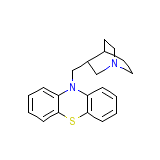Mircol




Mircol Brand names, Mircol Analogs
Mircol Brand Names Mixture
- No information avaliable
Mircol Chemical_Formula
C20H22N2S
Mircol RX_link
No information avaliable
Mircol fda sheet
Mircol msds (material safety sheet)
Mircol Synthesis Reference
G. Gueremy et al., Ger. pat. 2,009,555 corresp to U.S. pat. 3,987,042 (1970, 1976 to Sogeras)
Mircol Molecular Weight
322.468 g/mol
Mircol Melting Point
130.5 oC
Mircol H2O Solubility
No information avaliable
Mircol State
Solid
Mircol LogP
5.119
Mircol Dosage Forms
Tablet
Mircol Indication
For the treatment of Hay fever, urticaria (hives) and allergic rhinitis
Mircol Pharmacology
In allergic reactions an allergen interacts with and cross-links surface IgE antibodies on mast cells and basophils. Once the mast cell-antibody-antigen complex is formed, a complex series of events occurs that eventually leads to cell-degranulation and the release of histamine (and other chemical mediators) from the mast cell or basophil. Once released, histamine can react with local or widespread tissues through histamine receptors. Histamine, acting on H1-receptors, produces pruritis, vasodilatation, hypotension, flushing, headache, tachycardia, and bronchoconstriction. Histamine also increases vascular permeability and potentiates pain. Mequitazine is a histamine H1 antagonist. It competes with histamine for the normal H1-receptor sites on effector cells of the gastrointestinal tract, blood vessels and respiratory tract. It provides effective, temporary relief of sneezing, watery and itchy eyes, and runny nose due to hay fever and other upper respiratory allergies.
Mircol Absorption
No information avaliable
Mircol side effects and Toxicity
No information avaliable
Mircol Patient Information
No information avaliable
Mircol Organisms Affected
Humans and other mammals














